Get in touch with us at our toll-free number 1-800-835-2526 or request a quote here:
Protect Your Investment: Magnetic Separation for Mining
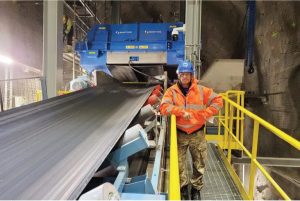
Mining and quarrying operations inevitably contend with tramp metal. The very act of extracting ore and aggregate using large, heavy equipment introduces a variety of metallic contaminants into the raw material. Operators must identify and remove this metal to prevent costly damage to processing equipment like crushers, screens, and conveyors. Moreover, many end-customers, especially power stations that use coal, specify maximum metal contamination levels in the delivered ore. This article explores the optimum magnetic separation methods that mining and quarrying operations employ to solve tramp metal removal problems.
The Origin of Quarrying and Mining Tramp Metal
For effective tramp metal removal, operators must first pinpoint its origins and characteristics. We define ‘tramp metal’ as any foreign metallic object that does not naturally occur within the extracted ore or aggregate. This includes contaminants like digger teeth, pit props, blasting caps, nuts, bolts, and metal fragments that result from process plant wear. Mining operations typically execute a multi-stage recovery of valuable ore. They reduce the ore’s particle size through crushing and milling, which liberates the ore from the gangue—the unwanted material. Then, they segregate the ore into specific size fractions using screening. Quarrying operations follow a comparable process for aggregates. In both mining and quarrying, these processing stages place equipment at high risk of damage from tramp metal.
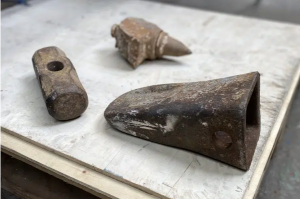
Protecting Processing Equipment: Tramp Metal Risks
Mining and quarrying operations expose critical processing equipment to the constant threat of tramp metal. Operators must safeguard these machines to maintain efficiency and prevent costly downtime.
Crushers
Operators utilize various crushing technologies to reduce ore and aggregate size across multiple stages. They primarily employ jaw and gyratory crushers for initial crushing, which leaves these machines vulnerable to large tramp metal impacts. Cone crushers, favored for secondary, tertiary, and quaternary stages, demonstrate high sensitivity to even small metal contaminants. Impact crushers, versatile machines, function at any crushing stage.
Jaw Crushers
Jaw crushers compress rock between a stationary and a mobile jaw. A pitman powers the moving jaw’s reciprocating motion. This crushing action breaks large boulders into smaller pieces. Tramp metal that enters the jaws damages the surface liners, compromising crushing efficiency and size accuracy. Large rogue metal pieces necessitate liner and pitman replacements.
Gyratory Crushers
Gyratory crushers feature an oscillating shaft that reduces material within a crushing cavity. An external bowl liner and an internal mantle, mounted on the oscillating shaft, perform the crushing. Continuous compression between these liners fragments the material. Additional crushing occurs as compressed particles interact, minimizing liner wear. Tramp metal severely damages the central mantle and can block the output. Blockages strain the system, leading to catastrophic internal crushing mechanism failures.
Cone Crushers
Cone crushers, similar to gyratory crushers, process smaller particle sizes. An eccentric shaft, driven by a gear and pinion, powers the main shaft’s oscillation. This oscillation causes the cone head to move between open and closed discharge settings. Crushing happens through continuous compression between the liners. Like gyratory crushers, cone crushers experience damage to the central mantle, concave, and bowl liner from tramp metal. Their operating nature makes them especially sensitive to all sizes of metal. High repair costs and component replacements result.
Impact Crushers
Impact crushers come in horizontal shaft impact (HSI) and vertical shaft impact (VSI) types. HSI crushers reduce feed material size through high-intensity impacts from rotor-mounted hammers or bars. Further fragmentation occurs as particles collide within the crusher chamber. VSI crushers, used in final crushing stages, produce precise cubical shapes. They function like centrifugal pumps, accelerating material through a rotor. The material crushes against the outer body and through particle collisions. Tramp metal damages rotors and impact plates, incurring significant repair costs and lost production revenue.
Safeguarding Screens: Maintaining Size Integrity in Mining and Quarrying
Mining and quarrying operations deploy diverse screen designs to meet varied processing needs, including dewatering, grizzly, linear, and trommel screens. Operators must protect these screens to ensure efficient material separation.
Grizzly and Trommel Screens
Operators typically position grizzly and trommel screens between the primary feeder and crusher. Grizzly screens direct mined rock across inclined, parallel steel bars or rails. They construct these screens from heavy-duty manganese steel or high-impact alloys for superior wear resistance. However, large, elongated tramp metal pieces can inflict damage. Similarly, elongated tramp metal causes wear, damage, and blockages in trommel screens, where mined rock enters large-diameter rotating drums. Trommel hole sizes determine screening particle size, with single trommels often separating multiple size fractions. Tramp iron obstructs trommels and damages the holes, altering sizing accuracy.
Linear Screens
Operators use single and double-deck linear screens for finer particle segregation later in the process. These screens employ various media, including wire and urethane, both vulnerable to tramp metal damage. Tramp metal can break metal wire screens, contaminating post-screened rock with new, smaller metal fragments. Tramp metal punctures or cuts urethane screens, affecting screening efficiency. Undetected screen damage leads to failures in meeting strict product sizing requirements.
Dewatering Screens
Dewatering screens remove moisture from materials, particularly in aggregate and mineral processing. Tramp metal impacting the inclined, linear-motion screen damages the screen surface, significantly reducing sizing efficiency.
Tramp Metal Removal: Strategies for Protection
Mining and quarrying operations tailor tramp metal control strategies to the specific rock, process, and contaminants present. They primarily employ magnetic separation and metal detection equipment to prevent processing plant damage.
Magnetic Separation
Magnetic separators automatically extract magnetically susceptible tramp metal, such as steel and iron, from the rock stream. Operators select the optimal magnetic separation design based on process and material specifications.
Overband and Suspension Magnets
Operators position overband or suspension magnets above conveyors to attract and remove tramp iron from the conveyed rock. Suspension magnets feature a magnet block that requires manual removal of separated metal, making them suitable for installations with infrequent metal contamination. Overband magnets incorporate a self-cleaning belt that automatically discharges captured metal into a collection area, providing the best option for higher metal contamination levels. Both suspension and overband magnets generate a magnetic field using either an enclosed casing of strategically arranged permanent magnets or an electromagnetic coil wound around a steel core.
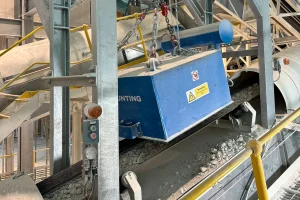
Mining and quarrying operations strategically deploy magnetic separation equipment to address diverse operational demands. They favor permanent overband and suspension magnets on mobile crushers and screens, especially in demolition waste recycling and quarry sites. Although some permanent designs function at high suspension heights, operators typically position them within 300mm of the conveyor to effectively remove larger, elongated tramp iron like rebar.
However, many mining operations utilize wide conveyors that transport substantial ore volumes and deep burdens. These conditions necessitate higher suspension heights and create challenging separation environments. Tramp metal frequently settles at the bottom of the burden, requiring a magnetic field strong enough to both attract and move it through the ore. These applications benefit from electro overband or suspension magnets, which generate a significantly deeper and more powerful magnetic field than permanent designs.
When electromagnetic coils project a deep and intense magnetic field, they produce considerable heat. As coil temperature rises, magnetic performance diminishes. Therefore, designers incorporate efficient coil cooling systems using either oil or air. In oil-cooled designs, they immerse the electromagnetic coil in a sealed oil bath within a metal enclosure. The circulating oil transfers heat from the coil to the enclosure’s outer walls, where it dissipates, and the oil cools. For enhanced magnetic performance in smaller coils, they force-cool the oil by passing it through externally mounted radiators and fans.
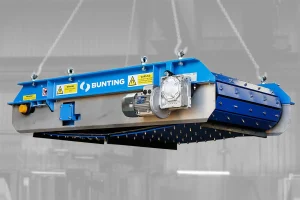
Designers implement various cooling mechanisms in air-cooled magnets, including fans that blow air directly onto the coil and aluminum fans that radiate outwards. Bunting specifically engineered their air-cooled ElectroMax model as a compact yet powerful electro overband or suspension magnet, ideal for installations with limited space. The electromagnet’s field shape and strength enhance the separation of smaller tramp iron, such as bolts and nuts.
Operators position both permanent and electromagnetic magnets as close as possible to the conveyed material for optimal metal separation. However, material surges can create variable burden depths. When overband or suspension magnets operate at a suspension height near the burden’s top, surges can cause conveyed rock to strike the magnet, damaging the magnet and self-cleaning belt mechanism. Surge protection systems, including sensors that automatically raise the magnetic separator and bars that spread and reduce the burden depth, prevent this damage.
Mining and quarrying installations frequently integrate overband or suspension magnets with metal detectors. The installation’s configuration dictates the metal detector’s placement, either before or after the magnetic separation equipment. In some setups, a metal detector positioned before an electromagnetic magnetic separator identifies tramp metal and signals the magnet to activate. This configuration suits installations with minimal metal contamination and a need for energy conservation. More commonly, the metal detector follows the magnetic separator to detect non-magnetic tramp metal that the magnet missed.
Case Study: Bunting designed and built a 13-tonne Electro Overband Magnet that operates in a gold mine in Northern Finland. Over a twelve-month period, this overband magnet removes damaging tramp metal from approximately 2.7 million tons of conveyed ore, protecting crushers, screens, and other upstream processing plant.
Magnetic Head Pulleys
Operators replace a conveyor’s standard head pulley with a permanent or electromagnetic magnetic head pulley. During operation, tramp iron in the conveyed rock is attracted to and held on the magnetic head pulley’s surface. As the returning conveyor leaves the pulley’s underside, gravity releases the separated tramp iron into a designated collection area.
Larger and heavier tramp metal tends to migrate to the burden’s bottom, making it more challenging to separate using suspension or overband magnets but easier with a magnetic head pulley. Long tramp metal poses difficulties for pulley separation due to limited magnetic field-to-metal contact as it passes over, especially when aligned with the flow.
Magnetic head pulleys suit existing installations with limited space, where installing overband or suspension magnets is impractical. These pulleys feature a continuous magnetic field covering the entire circumference. Permanent magnet designs consist of a solid structure where the entire pulley rotates as one, with the magnet element integrally bound to the outer shell. Electromagnetic versions feature a centralized stationary coil that generates a deep and strong magnetic field, making them suitable for high-volume mining applications.
Because the magnetic separator replaces the head pulley, manufacturers commonly coat the outer shell of both permanent and electromagnetic models with rubber lagging to enhance conveyor grip.
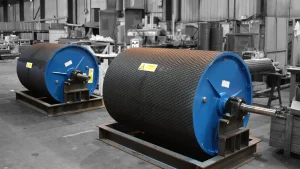
Case Study: Operators utilize two permanent magnetic head pulleys, each 1.2 meters in diameter, at an iron ore mine in Sweden. These pulleys remove large tramp metal from iron ore before crushing and screening. In this application, conveyors measure 1.2 meters wide and travel at 2 meters per second, transporting 650 tons of iron ore per hour with a bulk density of 2.4 tons per cubic meter. Because the pulley magnets function as drive pulleys, manufacturers lag them with rubber to enhance grip on the conveyor belt’s underside.
Drum Magnets
Operators often find drum magnets provide optimal tramp iron separation, although space limitations frequently hinder their installation. Drum magnets feature a centralized, stationary magnetic element (either permanent or electromagnetic) around which a non-magnetic shell rotates. Operators typically feed ore onto the rotating shell’s top via a vibratory feeder. Tramp metal and other magnetic materials attract to the magnetic element and adhere to the rotating shell, discharging when they exit the magnetic field beneath the drum. Non-magnetic material continues its normal trajectory, and a strategically placed splitter separates the two flows.
Drum magnets achieve the highest level of tramp metal separation, as magnetic particles flow close to the magnetic field. Larger diameter drum magnets, rotating at high speeds, process larger volumes of rock. The magnetic field’s close proximity to the rock enables stronger drum magnets, equipped with neodymium magnets, to separate weakly magnetic rocks—the target in numerous mineral beneficiation plants.
Manufacturers offer both permanent and electromagnetic drum magnet designs. Permanent models employ ceramic ferrite and rare earth neodymium magnets to generate either axial or radial magnetic fields.
Axial fields (with poles running across the drum magnet’s width) twist and turn captured tramp metal, releasing any entrapped ore. Radial field drum magnets (with poles running in the direction of flow) achieve the greatest level of magnetic separation but can lead to higher product loss due to entrapment. Typical applications for radial designs include recovering magnetically susceptible ores or removing weakly magnetic minerals from non-magnetic ores.
Metal Detection
Mining operations utilize metal detectors to identify all metal contamination, complementing magnetic separation that removes tramp iron. Metal detectors feature a coil, positioned either under-and-over or beneath a conveyor, through which or over which the conveyed rock passes. Metal detection occurs when tramp metal disturbs the magnetic field generated by the detector coil. Upon detecting metal, the detector sends a signal to a remote control. The control then stops the conveyor and activates an alarm, triggers a diverter gate to reject a material batch, or activates a subsequent overband or suspension magnet.
In large-volume mining operations, operators often cannot halt the conveyor. Instead, they divert a section of metal-contaminated ore into a collection area, where personnel manually inspect the rock or send it through a separate secondary system for tramp metal detection and removal. Designers offer various metal detector designs to suit diverse mining applications.
TN77 Industrial Metal Detectors
The tunnel-type TN77 industrial metal detector provides continuous inspection of non-metallic or non-conductive materials, pinpointing problematic tramp iron and manganese steels. Unlike many other metal detectors, the TN77 indicates the simultaneous detection of one or two tramp metal pieces. The detector also ignores non-magnetic copper-alloy belt fasteners, commonly found in rubber conveyor belts, which can cause false alarms.
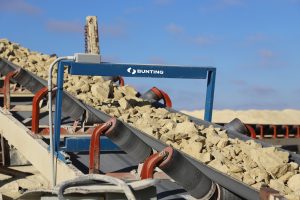
Case Study: Plasmor installed three Bunting metal detectors at their building block manufacturing site in Heck, East Yorkshire, UK, to detect tramp metal and protect processing plant equipment. The aggregate mix, which includes clay, Fuller’s earth (an industrial by-product), and recycled dust from the plant’s extraction systems, ensures zero waste production. Plasmor installed the three Bunting metal detectors on three separate material handling conveyors.
Customized Protection: Engineering Solutions for Tramp Metal Control
Tramp metal removal is critical to mining operations. Damage to crushers, screens, and conveyors disrupts or halts production, incurring substantial repair and downtime costs. Furthermore, failure to meet end-customer specifications for tramp metal content, particularly in coal-fired power stations, leads to costly financial penalties or even the rejection of entire material shipments.
Large-scale mining projects frequently necessitate custom-engineered equipment. Bunting’s applications engineering team collaborates closely with contractors and designers to understand project scope. Once they identify challenges, such as deep burden depths or wide conveyors, Bunting’s engineers design optimal magnetic separator and metal detector solutions, often tailored specifically to the project.
Bunting’s team has gained this understanding and knowledge by designing and manufacturing magnetic separators and metal detectors for large mining projects for over 40 years.